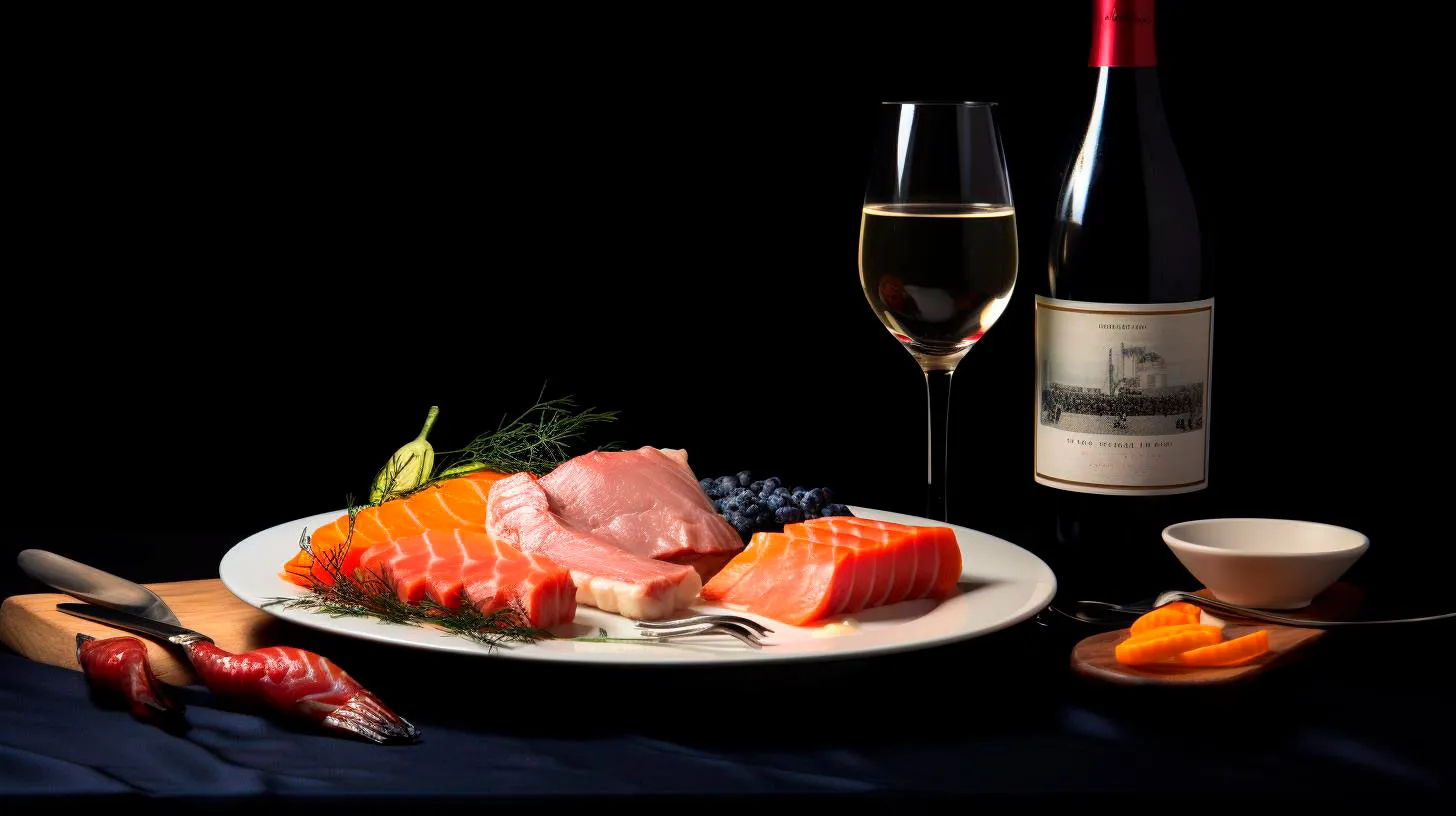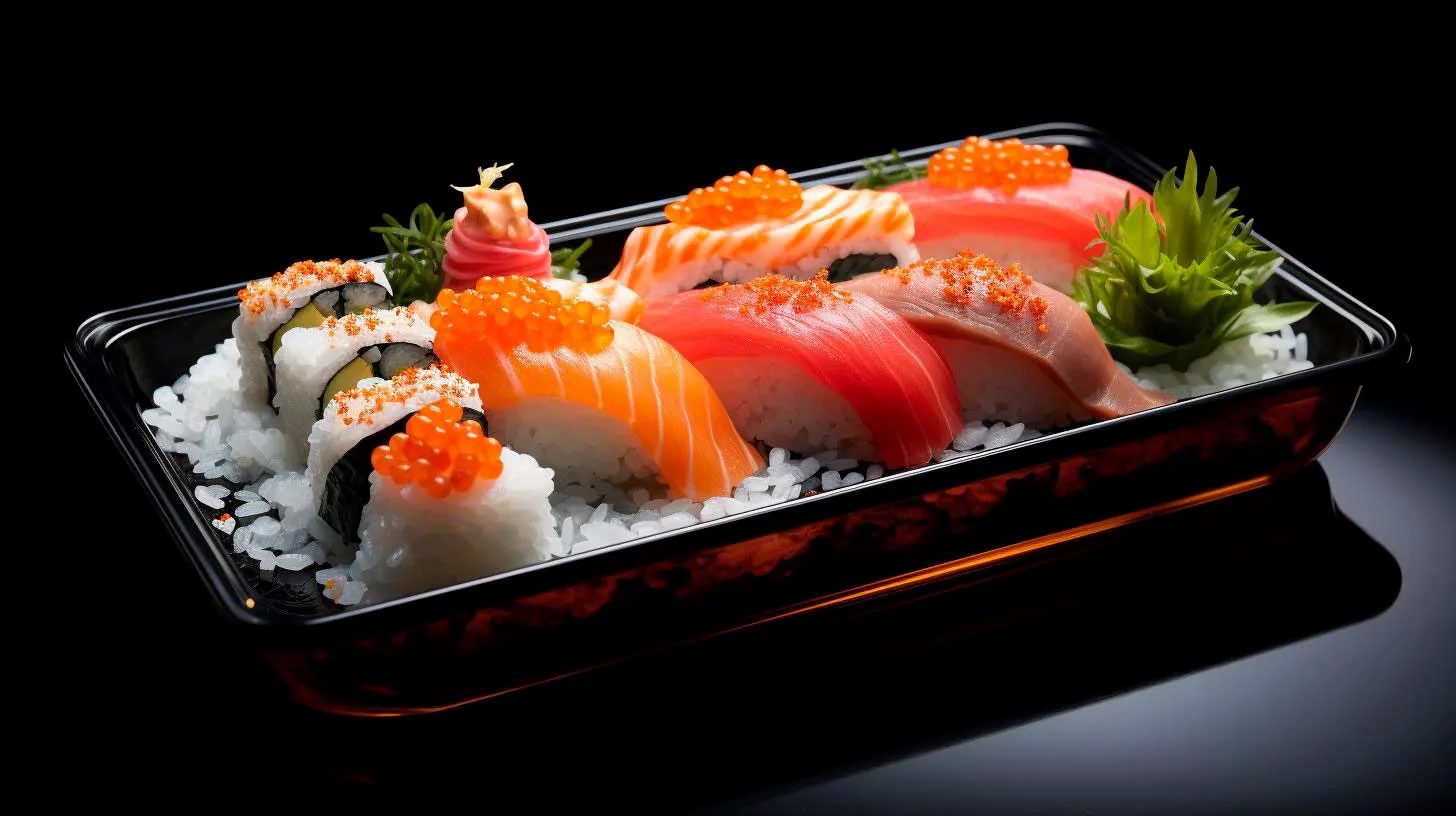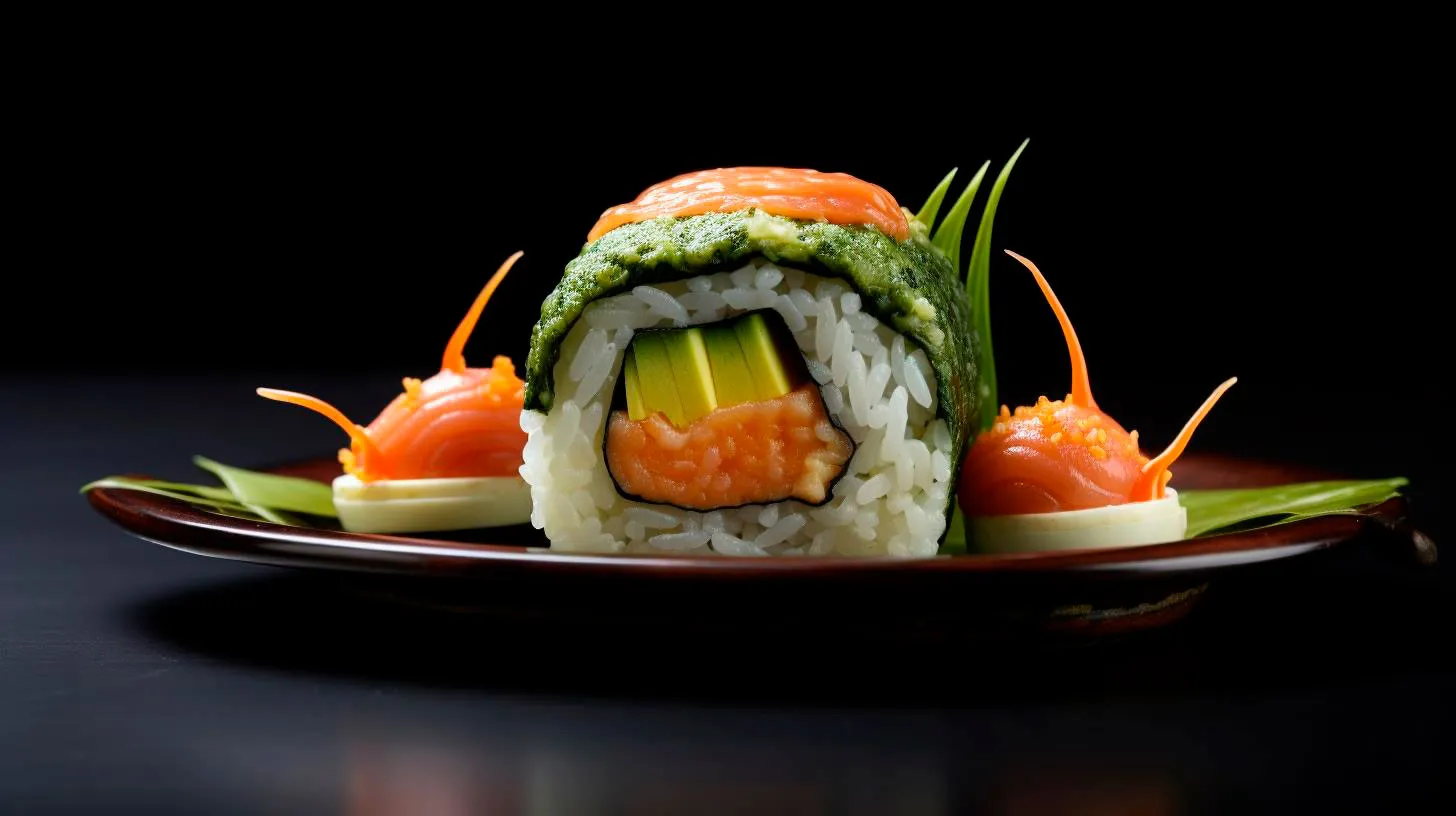Exquisite Presentation: Visual Creativity Enhances Michelin-Starred Sushi
The Michelin-starred sushi chefs have not only mastered the art of crafting delectable flavors but have also elevated sushi’s visual allure to the next level.
The Essence of Visual Creativity
For Michelin-starred sushi restaurants, exquisite presentation has become synonymous with their name. These chefs strive to create a multi-sensory experience for their customers, taking great care in how their sushi is arranged and served. Each dish is meticulously crafted to captivate diners visually, leaving a lasting impression that goes beyond mere taste.
- Visual creativity in sushi presentation elevates the overall dining experience.
- Meticulous attention to detail creates a feast for the eyes as well as the taste buds.
- The art of sushi presentation showcases the skills and creativity of the chef.
Key Techniques in Sushi Presentation
Making sushi visually appealing involves the mastery of several key techniques. These techniques not only enhance the aesthetic appeal but also highlight the freshness and quality of the ingredients:
1. Color Composition
A visually stunning sushi plate often includes a harmonious arrangement of colors. Chefs carefully select ingredients to create a balance between vibrant hues, ensuring that each piece is visually enticing. From the bright orange of salmon to the deep green of avocado, each color adds an element of visual pleasure to the dish.
2. Textural Variations
Adding different textures to sushi enhances its visual appeal. Chefs skillfully incorporate contrasting textures like silky smooth fish, crunchy vegetables, or crispy tempura. The play of textures not only creates an enticing visual contrast but also brings an added dimension of enjoyment to the dining experience.
3. Symmetry and Balance
Symmetry and balance are crucial in sushi presentation. Each piece is carefully shaped and arranged to create a sense of harmony on the plate. Precision and attention to detail are of utmost importance, ensuring that every roll or nigiri is visually pleasing and balanced.
4. Seasonal Themes
Many Michelin-starred sushi restaurants take inspiration from the seasons to create visuals that evoke a sense of time and place. By incorporating seasonal ingredients and natural elements such as cherry blossoms or autumn leaves, chefs not only enhance the visual appeal of the dish but also connect diners to the cultural context.
- Color composition, textural variations, and balance are key techniques in sushi presentation.
- Incorporating seasonal themes adds depth and cultural significance to the visual appeal.
Advantages of Visual Creativity in Sushi Presentation
The incorporation of visual creativity in sushi presentation serves multiple advantages, both for the chef and the diners. Here are some key benefits:
- Enhances Customer Experience: Visual creativity elevates the dining experience, making it memorable and unique.
- Increases Perceived Value: Well-presented sushi gives the impression of high-quality ingredients and craftsmanship.
- Expresses Chef’s Artistry: Visual creativity in sushi presentation allows chefs to showcase their artistic skills and culinary expertise.
- Generates Social Media Buzz: Eye-catching sushi presentations are highly shareable on social media platforms, attracting new customers.
The Future of Sushi Presentation
As the culinary world continues to evolve, sushi presentation is expected to push boundaries even further. With advancements in technology and a growing emphasis on experiential dining, chefs are exploring innovative techniques to captivate diners visually. From projection mapping on sushi plates to incorporating interactive elements, the future of sushi presentation holds exciting possibilities.
In conclusion, the visual creativity in Michelin-starred sushi presentation has revolutionized the way we perceive this traditional Japanese delicacy. By combining colors, textures, and seasonal elements, these talented sushi chefs create a remarkable dining experience that delights all the senses. So, the next time you indulge in sushi, appreciate not only its exquisite taste but also the visual artistry behind it.
Culinary Alchemy: Scientific Advances Reinvent Sushi Preparation
In this article, we will explore some of these cutting-edge developments that are transforming the way sushi is prepared and consumed.
The Rise of Sushi Robots
In the fast-paced world we live in, automation is a trend that has touched nearly every industry, and sushi preparation is no exception. Sushi robots use precision engineering and artificial intelligence to streamline the sushi-making process, ensuring consistent quality and reducing the time required to create delectable sushi rolls.
Advantages of sushi robots:
- Consistent quality: Sushi robots meticulously measure ingredients, ensuring the right amount of rice, fish, and vegetables are used to create perfectly proportioned sushi rolls.
- Increased efficiency: With sushi robots, chefs can produce a higher volume of sushi in less time, meeting the rising demand for this popular cuisine.
- Precision and accuracy: These machines are programmed to roll sushi with impeccable precision, resulting in visually stunning creations.
According to industry statistics, the global sushi robot market is expected to reach a value of $65 million by 2027, reflecting the growing adoption of this innovative technology.
Revolutionizing Sushi Rice with Nanotechnology
Sushi rice is an essential component of this iconic Japanese dish. Traditionally, sushi rice is cooked using a meticulous approach to achieve the perfect texture and consistency. However, recent advancements in nanotechnology have introduced rice cookers that utilize nanosensors to precisely control the cooking process.
The benefits of nanotechnology in sushi rice preparation:
- Consistency in texture: Nanosensors in rice cookers can monitor and adjust the cooking temperature and time, allowing sushi chefs to achieve consistent results every time.
- Enhanced flavor absorption: Nanotechnology can modify the surface of rice grains, enabling them to absorb flavors more efficiently and intensify the taste of each sushi roll.
- Time-saving: By reducing the cooking time, nanotechnology enables chefs to create sushi more efficiently without compromising on taste or quality.
Experts predict that the global nanotechnology market in the food industry will witness a compound annual growth rate (CAGR) of 13.5% from 2020 to 2027, indicating its potential impact on sushi preparation and other culinary practices.
Augmented Reality (AR) Sushi Experience
Augmented reality (AR) technology has taken the world by storm, and it is now making its way into the realm of sushi. With AR, sushi lovers can now enjoy an interactive and immersive dining experience.
Key takeaways from the AR sushi experience:
- Virtual sushi selection: Customers can use AR applications to visualize and select their desired sushi dishes before placing an order, enhancing their dining experience.
- Cultural exploration: AR can provide educational content, sharing interesting facts about the origin and preparation of each sushi type, giving customers a deeper understanding of the culinary traditions behind this cuisine.
- Visual appeal: AR technology can transform a simple sushi plate into a captivating visual spectacle, utilizing digital effects and animations to create an unforgettable dining experience.
With the global AR market projected to reach $39.7 billion by 2025, the fusion of this technology with sushi is set to redefine the way we perceive and enjoy this iconic cuisine.
Conclusion
As sushi continues to capture the hearts of food enthusiasts worldwide, scientific advances are revolutionizing its preparation. From the rise of sushi robots to nanotechnology-enhanced rice cookers and the integration of augmented reality, the art of sushi making is undergoing a transformative evolution.
With improved efficiency, consistency, and visual appeal, these advancements are not only changing the way sushi is prepared but also elevating the overall dining experience. Embracing technology while preserving the essence of this cherished culinary tradition, sushi will continue to captivate our taste buds well into the future.
Beyond Tradition and Techniques: Innovation in Michelin-Starred Sushi
In this article, we will explore the cutting-edge techniques and unique ingredients that have propelled sushi beyond its traditional roots.
The Rise of Michelin-Starred Sushi
Sushi has come a long way since its humble beginnings as a street food in Japan. Nowadays, it is not uncommon to find sushi restaurants with prestigious Michelin stars, a recognition of exceptional culinary skills and creativity. These establishments push the boundaries of traditional sushi and constantly strive for innovation, offering diners a gastronomic experience like no other.
Techniques Revolutionizing Sushi Making
- Sous-Vide: Sushi chefs have embraced the sous-vide technique, a method of cooking food in a vacuum-sealed bag at a precisely controlled temperature. This technique allows for enhanced flavors and textures, resulting in exceptional sushi creations that delight the taste buds.
- Hydrocolloids: By utilizing hydrocolloids, a group of substances commonly used in molecular gastronomy, sushi chefs have been able to experiment with different textures and presentations. From spherification to gels, these innovative techniques bring a sense of playfulness to the sushi dining experience.
- Smoking and Charring: While raw fish is a staple in traditional sushi, many Michelin-starred sushi restaurants have begun incorporating smoked or charred elements. This adds complexity and depth to the flavors, creating a unique sensory experience that sets them apart.
The Intriguing Ingredients
Moving beyond the traditional sushi pantry, Michelin-starred sushi chefs are exploring a plethora of new and intriguing ingredients. These include:
- Uni (Sea Urchin): Known for its rich and creamy texture, uni has become a sought-after ingredient in high-end sushi establishments. Its briny, slightly sweet flavor perfectly complements the delicate fish.
- Kobe Beef: The succulent and marbled Japanese Kobe beef has made its way into sushi creations, adding a luxuriously indulgent element to the traditional rice rolls.
- Truffle: Michelin-starred sushi chefs have embraced the aroma and earthy flavor of truffles, incorporating this prized ingredient in their sushi offerings. The marriage of delicate fish and truffle elevates the taste experience to new heights.
The Advantages of Innovation in Sushi
Embracing innovation in the world of sushi offers several advantages:
- Expanded Flavor Profiles: By incorporating new techniques and ingredients, sushi chefs can create bold and dynamic flavor profiles that intrigue and surprise the senses.
- Enhanced Textures: Innovations such as sous-vide and hydrocolloids allow for the creation of unique textures that tantalize the palate, adding another layer of enjoyment to the dining experience.
- Appealing to Modern Palates: Innovation in sushi appeals to those who seek forward-thinking and contemporary dining experiences. It offers an exciting alternative to traditional sushi and attracts a broader audience.
Key Takeaways
As sushi continues to evolve, Michelin-starred restaurants play a critical role in pushing the boundaries of tradition and technique. Their willingness to experiment with innovative methods and ingredients results in extraordinary culinary creations that enthrall diners worldwide.
- Michelin-starred sushi restaurants have revolutionized sushi making through techniques like sous-vide, hydrocolloids, and smoking.
- New and intriguing ingredients such as uni, Kobe beef, and truffle are being incorporated into sushi, adding complexity to the flavors.
- Innovation in sushi offers expanded flavor profiles, enhanced textures, and appeals to modern palates.
Ultimately, indulging in Michelin-starred sushi is not only a feast for the taste buds but also an exploration of the endless possibilities of culinary artistry. Step beyond tradition and experience the innovative world of sushi at its finest!
Pushing Boundaries: Modern Twists Elevate Traditional Sushi
Where Tradition Meets Innovation
A sushi roll isn’t just about raw fish and rice anymore. Chefs today are incorporating a plethora of unconventional ingredients, creative combinations, and unique techniques to take sushi to new heights. These modern twists are all about embracing diversity and appealing to a wider audience, both in terms of flavor profiles and dietary preferences.
Key Takeaway – Embracing Diversity:
- The evolution of sushi showcases the global influence on this traditional Japanese dish.
- Modern twists on sushi cater to different dietary preferences, ensuring inclusivity.
Let’s explore how sushi has been reinvented by highlighting a few standout modern approaches:
1. Fusion of Global Flavors
In today’s multicultural culinary landscape, fusion cuisine has become increasingly popular. Sushi is no exception. Chefs are skillfully merging traditional Japanese flavors with ingredients and techniques from other cuisines, creating a harmonious blend of tastes and textures. Whether it’s the tangy sweetness of Thai mango or the spicy kick of Mexican jalapenos, these unique combinations offer a delightful surprise for adventurous palates.
Key Takeaway – Fusion Flavors:
- Combining diverse flavors creates an exciting sensory experience.
- Experimenting with different cuisines attracts a broader range of food enthusiasts.
2. Plant-Based Sushi
The rise of plant-based diets has fueled an increased demand for vegetarian and vegan options, even in traditionally meat-heavy cuisines. Sushi is no exception, as innovative chefs are replacing fish with plant-based ingredients such as avocado, sweet potato, and tofu. These plant-based rolls not only celebrate the vibrancy of vegetables but also offer a healthier alternative without compromising on taste.
Key Takeaway – Plant-Based Options:
- Plant-based sushi satisfies the growing demand for vegetarian and vegan alternatives.
- It promotes sustainability and reduces the environmental impact of traditional fishing practices.
3. Exquisite Presentation
Sushi has always been known for its visually stunning presentation, and modern twists are taking it to the next level. Chefs are incorporating intricate designs, vibrant colors, and even edible flowers to create visually appealing masterpieces. These Instagram-worthy creations not only please the eyes but also enhance the overall dining experience.
Key Takeaway – Visual Appeal:
- The artful presentation of sushi engages all the senses and enhances the dining experience.
- Sharing visually stunning sushi on social media promotes the culinary craftmanship.
4. Interactive Dining Experiences
Modern sushi bars are no longer just places to grab a quick bite; they have evolved into immersive culinary experiences. Some restaurants offer sushi-making classes where patrons can unleash their creativity and craft their own personalized rolls. Others utilize interactive technology, such as conveyor belts or touch-screen ordering systems, to provide a unique dining adventure. These interactive elements make sushi more engaging and memorable, leaving guests with a lasting impression.
Key Takeaway – Interactive Experiences:
- Sushi-making classes offer a hands-on experience and build a deeper appreciation for the craft.
- Interactive technology enhances customer satisfaction and provides a memorable dining experience.
In conclusion, sushi is a dish that continues to captivate food enthusiasts worldwide. By embracing diversity, incorporating fusion flavors, offering plant-based options, presenting sushi as edible art, and providing interactive dining experiences, modern twists on traditional sushi have ushered in a new era of culinary innovation and excitement. So, the next time you indulge in sushi, prepare to be amazed by the ingenuity and creativity that elevate this timeless delicacy.
Fusion at its Finest: Unconventional Ingredients Redefine Sushi Artistry
Enter fusion sushi, a culinary phenomenon that blends unexpected ingredients and flavors to create a truly unique dining experience.
Embracing the Unconventional
Fusion sushi takes inspiration from different cuisines and cultures, incorporating ingredients that are not typically associated with traditional sushi. This innovation has opened up a world of possibilities, allowing chefs to create exciting and unexpected flavor combinations. By exploring new ingredients and techniques, fusion sushi offers a taste adventure like no other.
Here are some of the unconventional ingredients that have found their way into fusion sushi:
- Mango: The sweetness of ripe mango complements the umami flavors of sushi, adding a refreshing and tropical twist.
- Avocado: Creamy avocado adds a buttery texture to sushi rolls, balancing out the flavors and providing a smooth finish.
- Truffle oil: The earthy and intense flavor of truffle oil elevates sushi to a whole new level, creating a decadent and luxurious experience.
- Sweet potato: Roasted sweet potatoes bring a delightful sweetness and a satisfying crunch to sushi rolls, creating a unique flavor and texture combination.
- Quinoa: As a healthier alternative to rice, quinoa adds a nutty flavor and a satisfying chewiness to sushi, appealing to health-conscious diners.
Advantages of Fusion Sushi
The rise of fusion sushi has brought numerous benefits to both chefs and diners. Here are some of the advantages:
- Creativity: Fusion sushi encourages chefs to think outside the box and experiment with new ingredients, leading to the creation of innovative and visually stunning dishes.
- Expanded Palate: By incorporating unconventional ingredients, fusion sushi offers a wider range of flavors, expanding the culinary horizons of diners and stimulating their taste buds.
- Diversity: Fusion sushi allows for the fusion of different culinary traditions and techniques, promoting cross-cultural appreciation and understanding.
- Healthier Options: With the inclusion of ingredients like quinoa and vegetables, fusion sushi provides healthier alternatives without compromising on taste.
- Engaging Dining Experience: Fusion sushi adds an element of surprise and excitement to the dining experience, making it more interactive and memorable.
Key Takeaways
Fusion sushi has emerged as a creative and exciting trend within the culinary world. By blending unconventional ingredients and flavors, fusion sushi has pushed the boundaries of traditional sushi, captivating the palates of adventurous food enthusiasts.
Key takeaways to remember about fusion sushi:
- Fusion sushi incorporates unconventional ingredients such as mango, avocado, truffle oil, sweet potato, and quinoa.
- It encourages creativity and experimentation among chefs, leading to the creation of visually stunning and innovative dishes.
- Fusion sushi expands the palate of diners, offering a wider range of flavors and textures.
- It promotes cultural diversity and cross-cultural appreciation by fusing culinary traditions.
- Fusion sushi provides healthier alternatives without compromising on taste.
So, the next time you find yourself craving sushi, why not step out of your comfort zone and give fusion sushi a try? Unleash your taste buds and indulge in a culinary adventure that showcases the artistry of unconventional ingredients.



